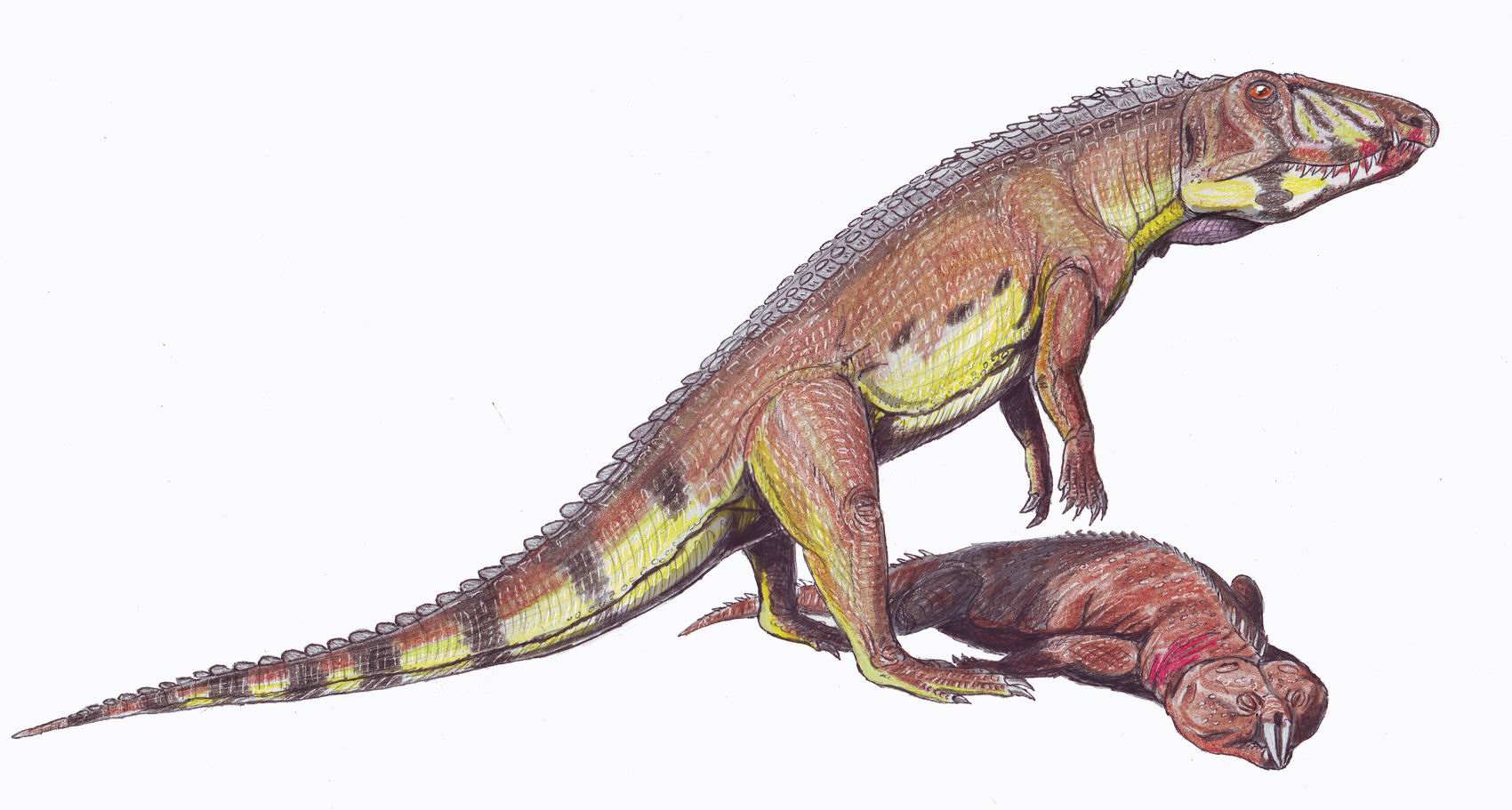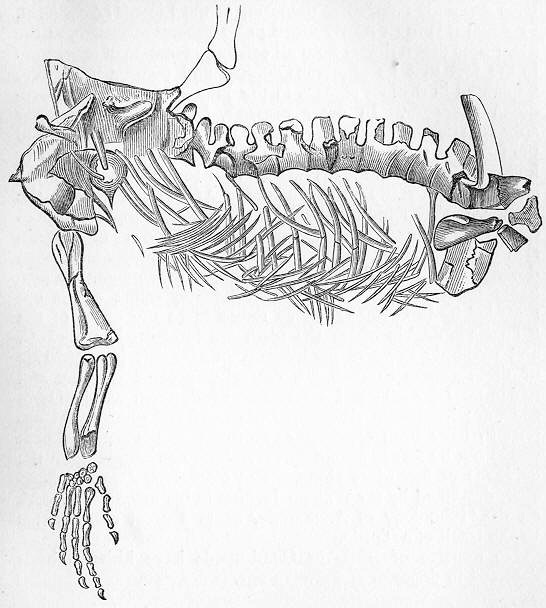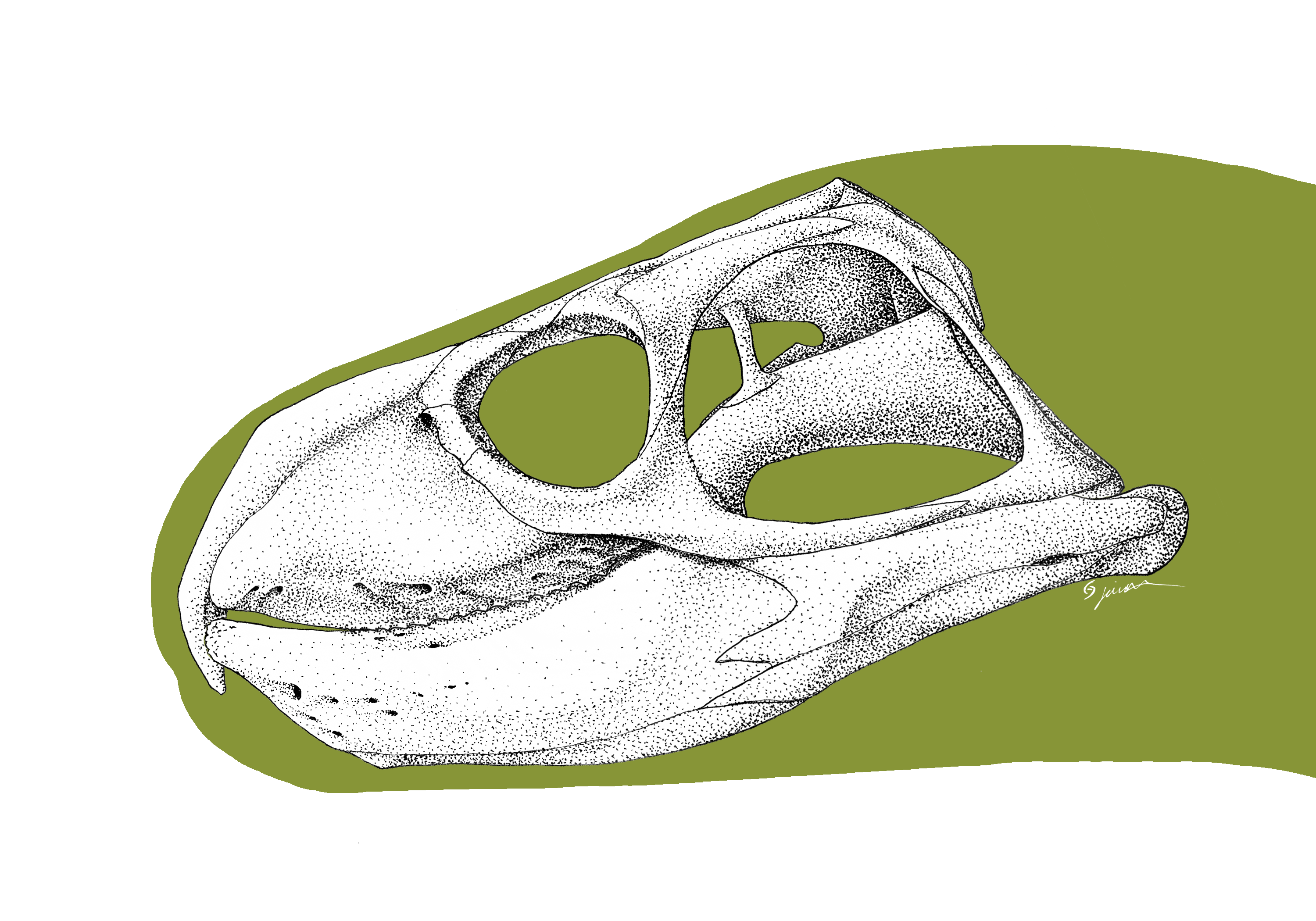|
Allokotosauria
Allokotosauria is a clade of early archosauromorph reptiles from the Middle to Late Triassic known from Asia, Africa, North America and Europe. Allokotosauria was first described and named when a new monophyletic grouping of specialized herbivorous archosauromorphs was recovered by Sterling J. Nesbitt, John J. Flynn, Adam C. Pritchard, J. Michael Parrish, Lovasoa Ranivoharimanana and André R. Wyss in 2015. The name Allokotosauria is derived from Greek meaning "strange reptiles" in reference to unexpected grouping of early archosauromorph with a high disparity of features typically associated with herbivory. History Nesbitt ''et al.'' (2015) defined the group as a stem-based taxon containing ''Azendohsaurus madagaskarensis'' and '' Trilophosaurus buettneri'' and all taxa more closely related to them than to ''Tanystropheus longobardicus'', ''Proterosuchus fergusi'', ''Protorosaurus speneri'' or ''Rhynchosaurus articeps''. Therefore, Allokotosauria includes the families Azendoh ... [...More Info...] [...Related Items...] OR: [Wikipedia] [Google] [Baidu] |
Pamelaria
''Pamelaria'' is an extinct genus of allokotosaurian archosauromorph reptile known from a single species, ''Pamelaria dolichotrachela'', from the Middle Triassic of India. ''Pamelaria'' has sprawling legs, a long neck, and a pointed skull with nostrils positioned at the very tip of the snout. Among early archosauromorphs, ''Pamelaria'' is most similar to ''Prolacerta'' from the Early Triassic of South Africa and Antarctica. Both have been placed in the family Prolacertidae. ''Pamelaria'', ''Prolacerta'', and various other Permo-Triassic reptiles such as ''Protorosaurus'' and ''Tanystropheus'' have often been placed in a group of archosauromorphs called Protorosauria (alternatively called Prolacertiformes), which was regarded as one of the most basal group of archosauromorphs. However, more recent phylogenetic analyses indicate that ''Pamelaria'' and ''Prolacerta'' are more closely related to Archosauriformes than are ''Protorosaurus'', ''Tanystropheus'', and other protorosaurs, ... [...More Info...] [...Related Items...] OR: [Wikipedia] [Google] [Baidu] |
Azendohsauridae
Azendohsauridae is a family of allokotosaurian archosauromorphs that lived during the Middle to Late Triassic period, around 242-216 million years ago. The family was originally named solely for the eponymous ''Azendohsaurus'', marking out its distinctiveness from other allokotosaurs, but the family now includes four other genera: the basal genus '' Pamelaria'', the large horned herbivore '' Shringasaurus'', and two carnivorous genera grouped into the subfamily-level subclade Malerisaurinae, '' Malerisaurus'' and '' Puercosuchus'', and potentially also the dubious genus ''Otischalkia''. Most fossils of azendohsaurids have a Gondwanan distribution, with multiple species known across Morocco and Madagascar in Africa as well as India, although fossils of malerisaurine azendohsaurids have also been found in the southwestern United States of North America. Azendohsaurids are notable for the various dinosaur-like traits found in some species, including the sauropodomorph-like nec ... [...More Info...] [...Related Items...] OR: [Wikipedia] [Google] [Baidu] |
Archosauromorph
Archosauromorpha (Greek for "ruling lizard forms") is a clade of diapsid reptiles containing all reptiles more closely related to archosaurs (such as crocodilians and dinosaurs, including birds) rather than lepidosaurs (such as tuataras, lizards, and snakes). Archosauromorphs first appeared during the late Middle Permian or Late Permian, though they became much more common and diverse during the Triassic period. Although Archosauromorpha was first named in 1946, its membership did not become well-established until the 1980s. Currently Archosauromorpha encompasses four main groups of reptiles: the stocky, herbivorous allokotosaurs and rhynchosaurs, the hugely diverse Archosauriformes, and a polyphyletic grouping of various long-necked reptiles including ''Protorosaurus'', tanystropheids, and ''Prolacerta''. Other groups including pantestudines (turtles and their extinct relatives) and the semiaquatic choristoderes have also been placed in Archosauromorpha by some authors. A ... [...More Info...] [...Related Items...] OR: [Wikipedia] [Google] [Baidu] |
Arctosaurus
''Arctosaurus'' is an extinct genus of archosauromorph, possibly an allokotosaurian, but was often classified as a sauropodomorph dinosaur between 1900 and 1976. Although it has also been classified as a theropod, recent review finds that the similarities it shares with theropods are spread throughout several groups of Late Triassic reptiles, and so it cannot be assigned any more specifically than to Archosauriformes. Other authors have suggested trilophosaurian affinities. Based on the size of the vertebra, a size of about in length is extrapolated. Discovery and naming It is based on holotype NMING: F14878, a neck vertebra that was found in 1859 by Captain Sherard Osborn on Cameron Island, Nunavut, Canada, in Late Triassic-age rocks of the Heiberg Formation The Heiberg Formation is a geological Formation (geology), formation in Northwest Territories, Canada.Weishampel, David B; et al. (2004). "Dinosaur distribution (Late Triassic, North America)." In: Weishampel, David B.; ... [...More Info...] [...Related Items...] OR: [Wikipedia] [Google] [Baidu] |
Anisian
In the geologic timescale, the Anisian is the lower stage or earliest age of the Middle Triassic series or epoch and lasted from million years ago until million years ago. The Anisian Age succeeds the Olenekian Age (part of the Lower Triassic Epoch) and precedes the Ladinian Age. Stratigraphic definitions The stage and its name were established by Austrian geologists Wilhelm Heinrich Waagen and Carl Diener in 1895. The name comes from ''Anisus'', the Latin name of the river Enns. The original type locality is at Großreifling in the Austrian state of Styria. The base of the Anisian Stage (also the base of the Middle Triassic series) is sometimes laid at the first appearance of conodont species '' Chiosella timorensis'' in the stratigraphic record. Other stratigraphers prefer to use the base of magnetic chronozone MT1n. There is no accepted global reference profile for the base, but one ( GSSP or golden spike) was proposed at a flank of the mountain Deşli Caira in the Roman ... [...More Info...] [...Related Items...] OR: [Wikipedia] [Google] [Baidu] |
Proterosuchus Fergusi
''Proterosuchus'' is an extinct genus of archosauriform reptiles that lived during the Early Triassic. It contains three valid species: the type species ''P. fergusi'' and the referred species ''P. alexanderi'' and ''P. goweri''. All three species lived in what is now South Africa. The genus was named in 1903 by the South African paleontologist Robert Broom. The well-known genus ''Chasmatosaurus'' is a junior synonym of ''Proterosuchus''. ''Proterosuchus'' was a mid-sized quadrupedal reptile with a sprawling stance that could reach a length of up to . It had a large head and distinctively hooked snout. It was a predator, which may have hunted prey such as ''Lystrosaurus''. The lifestyle of ''Proterosuchus'' remains debated; it may have been terrestrial or it may have been a semiaquatic ambush predator similar to modern crocodiles. ''Proterosuchus'' is one of the earliest members of the clade Archosauriformes, which also includes crocodilians, pterosaurs, and dinosaurs, inc ... [...More Info...] [...Related Items...] OR: [Wikipedia] [Google] [Baidu] |
Protorosaurus Speneri
''Protorosaurus'' ("first lizard") is a genus of lizard-like early reptiles. Members of the genus lived during the late Permian period in what is now Germany and Great Britain. Once believed to have been an ancestor to lizards, ''Protorosaurus'' is now known to be one of the oldest and most primitive members of Archosauromorpha, the group that would eventually lead to archosaurs such as crocodilians and dinosaurs. Description ''Protorosaurus'' grew up to in length, and was a slender, lizard-like animal, vaguely resembling a monitor lizard, with long legs and a long neck. Discovery ''Protorosaurus'' was one of the first fossil reptiles to be described, being initially described in Latin in 1710 by from a specimen found in Thuringia in Germany, who considered the animal to be a crocodile, and most similar to the Nile crocodile (''C. niloticus''). Over a century later, in publications in 1830 and 1832 Hermann von Meyer recognised ''Protorosaurus'' as distinct extinct rep ... [...More Info...] [...Related Items...] OR: [Wikipedia] [Google] [Baidu] |
Rhynchosaurus Articeps
''Rhynchosaurus'' (''beaked lizard'') is a genus of rhynchosaur that lived during the Middle Triassic period. It lived in Europe. It was related to the archosaurs, but not within that group. The type species of ''Rhynchosaurus'' is ''R. articeps''. Michael Benton named two additional species, ''R. spenceri'' and ''R. brodiei'', but they were subsequently renamed ''Fodonyx'' and ''Langeronyx'' respectively.Martín D. Ezcurra, Felipe Montefeltro and Richard J. Butler (2016). "The Early Evolution of Rhynchosaurs". Frontiers in Ecology and Evolution 3: Article 142. doi:10.3389/fevo.2015.00142. Fossils of ''Rhynchosaurus'' have been found in the Tarporley Siltstone Formation (Mercia Mudstone Group) and possibly the Sherwood Sandstone Group of the United Kingdom.''Rhynchosaurus'' at |
Basal (phylogenetics)
In phylogenetics, basal is the direction of the ''base'' (or root) of a phylogenetic tree#Rooted tree, rooted phylogenetic tree or cladogram. The term may be more strictly applied only to nodes adjacent to the root, or more loosely applied to nodes regarded as being close to the root. Note that extant taxa that lie on branches connecting directly to the root are not more closely related to the root than any other extant taxa. While there must always be two or more equally "basal" clades sprouting from the root of every cladogram, those clades may differ widely in taxonomic rank, Phylogenetic diversity, species diversity, or both. If ''C'' is a basal clade within ''D'' that has the lowest rank of all basal clades within ''D'', ''C'' may be described as ''the'' basal taxon of that rank within ''D''. The concept of a 'key innovation' implies some degree of correlation between evolutionary innovation and cladogenesis, diversification. However, such a correlation does not make a given ca ... [...More Info...] [...Related Items...] OR: [Wikipedia] [Google] [Baidu] |
Middle Triassic
In the geologic timescale, the Middle Triassic is the second of three epochs of the Triassic period or the middle of three series in which the Triassic system is divided in chronostratigraphy. The Middle Triassic spans the time between Ma and Ma (million years ago). It is preceded by the Early Triassic Epoch and followed by the Late Triassic Epoch. The Middle Triassic is divided into the Anisian and Ladinian ages or stages. Formerly the middle series in the Triassic was also known as Muschelkalk. This name is now only used for a specific unit of rock strata with approximately Middle Triassic age, found in western Europe. Middle Triassic fauna Following the Permian–Triassic extinction event, the most devastating of all mass-extinctions, life recovered slowly. In the Middle Triassic, many groups of organisms reached higher diversity again, such as the marine reptiles (e.g. ichthyosaurs, sauropterygians, thallatosaurs), ray-finned fish and many invertebrate groups like ... [...More Info...] [...Related Items...] OR: [Wikipedia] [Google] [Baidu] |
India
India, officially the Republic of India (Hindi: ), is a country in South Asia. It is the seventh-largest country by area, the second-most populous country, and the most populous democracy in the world. Bounded by the Indian Ocean on the south, the Arabian Sea on the southwest, and the Bay of Bengal on the southeast, it shares land borders with Pakistan to the west; China, Nepal, and Bhutan to the north; and Bangladesh and Myanmar to the east. In the Indian Ocean, India is in the vicinity of Sri Lanka and the Maldives; its Andaman and Nicobar Islands share a maritime border with Thailand, Myanmar, and Indonesia. Modern humans arrived on the Indian subcontinent from Africa no later than 55,000 years ago., "Y-Chromosome and Mt-DNA data support the colonization of South Asia by modern humans originating in Africa. ... Coalescence dates for most non-European populations average to between 73–55 ka.", "Modern human beings—''Homo sapiens''—originated in Africa. Then, int ... [...More Info...] [...Related Items...] OR: [Wikipedia] [Google] [Baidu] |
Azendohsaurus Madagaskarensis
''Azendohsaurus'' is an extinct genus of herbivorous archosauromorph reptile from roughly the late Middle to early Late Triassic Period of Morocco and Madagascar. The type species, ''Azendohsaurus laaroussii'', was described and named by Jean-Michel Dutuit in 1972 based on partial jaw fragments and some teeth from Morocco. A second species from Madagascar, ''A. madagaskarensis'', was first described in 2010 by John J. Flynn and colleagues from a multitude of specimens representing almost the entire skeleton. The generic name "Azendoh lizard" is for the village of Azendoh, a local village near where it was first discovered in the Atlas Mountains. It was a bulky quadruped that unlike other early archosauromorphs had a relatively short tail and robust limbs that were held in an odd mix of sprawled hind limbs and raised forelimbs. It had a long neck and a proportionately small head with remarkably sauropod-like jaws and teeth. ''Azendohsaurus'' used to be classified as a herbivo ... [...More Info...] [...Related Items...] OR: [Wikipedia] [Google] [Baidu] |






